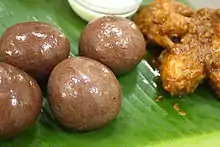Ragi mudde
Ragi Mudde, Ragi Sangati or kali and colloquially simply referred to as either 'Mudde' (which means 'lump') or 'Hittu' - i.e. flour); is a wholesome meal in the state of Karnataka and the Rayalaseema region in Andhra Pradesh.[1] It is mainly popular with the rural folk of Karnataka. In Tamil Nadu, especially in Western Tamil Nadu it is called Ragi Kali. Ragi mudde main food in Kolar, Mandya, Hassan, Mysore, Tumkur districts in Karnataka.The Similar variation known as Dhindo is also eaten in Northeast India, Nepal and Bhutan.
 | |
| Alternative names | Ragi Sangati, Ragi kali |
|---|---|
| Course | Lunch or Dinner |
| Place of origin | India |
| Region or state | Karnataka, Andhra & Telangana, Tamilnadu |
| Serving temperature | Hot |
| Main ingredients | Finger millet |


Preparation
Ragi mudde, a store house of multi nutrients, has only two ingredients, the Ragi (finger millet) flour and water. A tablespoon of Ragi flour is first mixed with water to make a very thin paste and later added to a thick bottomed vessel containing water on a stove top. As this mixture boils and reaches the brim of the vessel, ragi flour is added which forms a mound on top of boiling water. The flour is allowed to cook in this fashion on medium high flame. Later with the help of a wooden stick (Kannada: ಮುದ್ದೆ ಕೋಲು: mudde kolu / Kannada: ಹಿಟ್ಟಿನ ದೊಣ್ಣೆ: hiTTin doNNe), the flour is beaten to a smooth dough like consistency with no lumps. This hot dough is then rested on low heat before rounding them on a wooden board into tennis ball sized balls with wet hands. Thus prepared Ragi balls are broken down into smaller balls using fingers and swallowed hot dipping them in 'saaru' Kannada: ಹೆಸ್ರು/ 'hesru' Kannada: ಹೆಸ್ರು, chutney or gojju. It is not supposed to be chewed. Mudde, by itself, does not have a strong taste. Ragi Mudde is traditionally eaten with saaru (made of greens with sprouted grams, meat or vegetables), but can also be eaten with yogurt or butter milk. The saaru is often flavoured by mixing a dash of spicy, freshly ground green-chilli paste (Kannada: ಖಾರ "Khaara"), in one's plate - according to taste. "Ragi Mudde-Bassaru" is a popular combination among the farming communities in Karnataka. Bassaru is made from the decanted water, which remains after (an assortment of) pulses are steamed (usually along with a couple of pods of garlic). This water takes up the earthy flavour of the pulses to nicely complement the earthy flavour of the 'Mudde' itself. Browned onions, red chillies, and some garlic are browned, and then ground into a paste along with grated coconut. This is added to the water, and the mixture is finally seasoned with oggarane.[2] The steamed pulses themselves are often used to prepare a dry side salad known as 'palya' (Kannada: ಪಲ್ಯ).
There are numerous variations of 'Bassaru', which each yield a differently named (usually, eponymous with the major ingredient) saaru. Bassaru is itself the portmanteau of 'Bas(tira)' (Kannada: ಬಸ್ತಿರ) (steamed) and 'saaru'. 'Uppesru' (Kannada: ಉಪ್ಪೆಸ್ರು)/ 'Uppsaaru' (Kannada: ಉಪ್ಪ್ಸಾರು) is another common accompaniment to 'mudde'. This is often simply a stew comprising steamed horsegram, as well as the water used to steam it; with added salt. Sometimes, hyacinth-beans (Kannada: ಅವರೇಕಾಳು 'AvarekaaLu') replace the horsegram. The horsegram version is also known as 'HurLi saaru' (Kannada: ಹುರಳಿ ಸಾರು).
Ragi mudde is rich in the same nutrients that are found in Finger millet - namely fibre, Calcium, and Iron.
Eaten with
Ragi mudde is consumed with the famous Karnataka style Upsaaru, Bassaaru or Chicken curry or Menthyada Gojju (sweet sour dish made of Fenugreek and Tamarind). It is the most famous and almost a daily food for most of the south Karnataka/old Mysore place. Many luxury hotels serve Ragi Mudde on special occasions.
See also
Notes
- "Ragi Sangati". The Hindu. 21 June 2008. ISSN 0971-751X. Retrieved 25 March 2016.
- "Padma's Recipes: BASSARU( GREENS CURRY)". Retrieved 3 September 2014.
